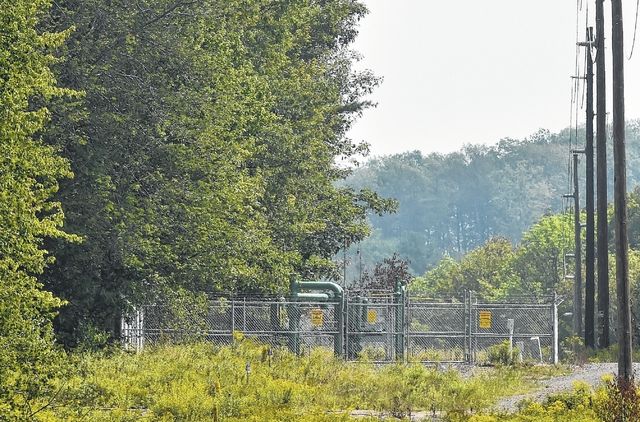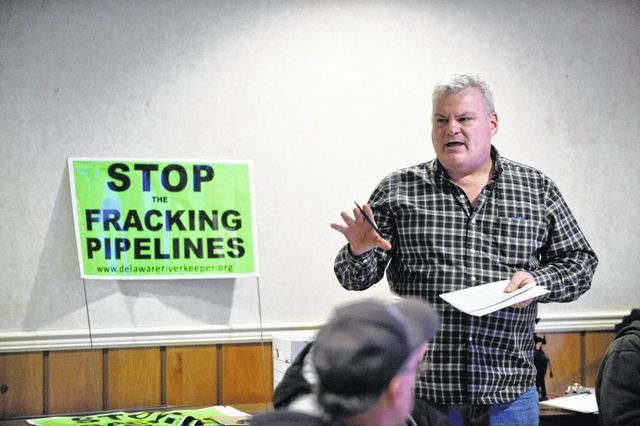Click here to subscribe today or Login.
DALLAS TWP. — Will the Back Mountain area of Luzerne County soon be known as “Gas Mountain?” And what will that mean to the people who live, work and go to school there?
Those are questions raised by opponents of pipelines and other natural gas infrastructure, some of it already present in this largely residential municipality of about 9,000, and in neighboring communities. With three new high-pressure pipeline projects in the works and more on the drawing board, they worry about safety, loss of property, destruction of the environment and other potential effects.
“How many pipelines are enough; I think we need to ask that question,” said Scott Cannon, media director of the anti-fracking nonprofit Gas Drilling Awareness Coalition, headquartered here.
The presence of pipelines and gas treatment facilities just over a quarter mile from the Dallas School District campus – and the possibility there will be more – adds a special urgency.
“It just doesn’t seem like a good mix,” Cannon said.
Unlike four years ago, when Chief Gathering was proposing to construct a compressor station along the Transcontinental interstate pipeline near the school campus, there has been little pushback against the new pipelines. Public opposition to that facility, which could have held several powerful compressor engines and been easily visible and noisy, is credited with forcing the company to relocate it outside the township and away from the schools.
Pipelines, by comparison, are mostly hidden from sight and the metering stations that are installed where lines connect to the Transco are smaller and less noisy, although not without their annoyances.
Out of sight may mean out of mind.
“The parents came out in force” against the Chief project, but now it doesn’t seem like anyone is paying attention, Cannon said.
One off table
Cannon breathed a small sigh of relief when told that one proposed pipeline, Williams’ Diamond East, was not going forward because customer commitments did not materialize during “open season,” the period when pipeline builders seek contracts to transport sufficient volumes of gas to justify construction.
“Currently it’s not an active project; we haven’t filed,” said Chris Stockton, a Williams spokesperson. “We have to have firm market support and will not build on speculation. If needs change in the future, we could pursue it.”
Developers of the MARC II pipeline that would transport gas from Lycoming County have not yet filed their intentions with the Federal Energy Regulatory Commission, known as FERC, which regulates interstate pipelines.
Elizabeth Suman, spokesperson for Crestwood Midstream, would not comment beyond statements in the company’s second-quarter earnings report, where it said negotiations with customers and design work are ongoing, with a possible connection in Dallas Township in late 2017.
That leaves as active projects Williams’ Atlantic Sunrise, which would run across northern Luzerne County into Columbia County before turning south to an interstate connection in Maryland; Williams’ Leidy Southeast Expansion of its Transco line, and PennEast Pipeline, planned by a consortium of utilities and investors including UGI Energy Services that would run down the eastern edge of Luzerne County and on to New Jersey.
Fears for Dallas schools
While the Atlantic Sunrise and Leidy projects expand the capacity of the Transco pipeline, the 36-inch diameter PennEast would require a new interconnection with the Transco near the Dallas School District campus, where two smaller and lower pressure gathering lines that bring gas from the Marcellus Shale fields to the north already are connected. That worries Cannon.
“When you put five pipelines together you multiply the risks. Putting it that close to a school doesn’t make sense to me,” he said.
Dallas Township Supervisor Liz Martin agrees. “I think (an accident is) a more remote possibility when it’s only one,” she said. But with multiple lines, “it makes me nervous. The scary thing is the lines that will be coming will be bigger.”
The connection for the former Chief line and metering station, now owned by Energy Transfer Partners, is less than 1,500 feet from schools and a gathering line owned by Williams is a few hundred feet further away. Maps of the high-pressure PennEast line show it connecting between those two, and while that would be nearly twice the “blast radius” in the event of an explosion, it is well within the recommended evacuation zone to avoid burns as calculated by the Pipeline Association for Public Awareness.
School and township officials have been working to open communication with the pipeline developers, which are under no legal obligation to inform them about activities on the lines or at metering stations that are installed at each connection.
Tom Duffy, superintendent of the Dallas School District, said he has a working relationship with both Williams and UGI, so that “we can educate ourselves and educate our district on the what-ifs and maybes. If there are glaring concerns, we’re certainly going to let them be known,” he said.
Williams has provided “tabletop” exercises for various scenarios that school, police and fire personnel have conducted and this summer discussions were held about possible responses to threats to the campus, including a gas line explosion.
Evacuation plan
“We definitely have an evacuation plan from the campus,” with high school and middle school students going to Misericordia University and students in the two elementary schools going to a local church, Duffy said. A surprise drill is under consideration, but he has concerns about its effect on young children.
“You want to have that preparedness, but you’re going to have crying 5-year-olds,” which may disturb parents.
Following a 2013 incident in which the high school was disrupted by a release of mercaptin, infused into the gas at the metering station to give a telltale odor, Duffy said emergency shut-offs to ventilation systems have been installed in principal’s offices at the four school buildings on the campus, so that outside air can be kept out. And the Dallas Fire and EMS, which is less than a mile away, has portable sensors and other equipment that can be brought to the campus quickly.
Alan Pugh, emergency services coordinator for the township, said there has been more cooperation lately. He has toured both the Williams and Energy Transfer Partners facilities, and recently worked with ETP on line bleeding, a standard maintenance procedure.
Normally gas would be vented into the atmosphere, he said, but because of proximity to the schools it was burned it off, avoiding raising alarms over the odor.
“We can’t tell them to do that, but we asked and were happy they did it,” Pugh said.
FERC role
Critics of FERC say it merely rubber stamps pipeline projects, but it has denied a large number of applications. While its oversight is limited by Congress to environmental and construction reviews, those can be applied broadly.
For example, if it appears pipelines are redundant, “the environmental reports will look at alternatives, including co-location perhaps if they’re serving the same customers,” said Tamara Young-Allen, a commission spokesperson.
Staff also will look at the cumulative impact on a region, and could suggest alternatives, whether or not the facilities are within FERC’s jurisdiction, which is confined to interstate transmission pipelines.
Property owners and other affected parties can submit comments to FERC, which can ask pipeline developers to respond as part of the review process. Several Luzerne County individuals have commented on the Atlantic Sunrise and PennEast lines. While those have mostly been from the Back Mountain, recent comments have come as the result of a rerouting for PennEast in the Plains Township and Laflin areas.
More comments will be accepted at public hearings to be held after FERC releases a draft environmental impact statement for each project.
Cannon, meanwhile, hopes there will be an upswell in protest over the potential dangers of the “Dallas gas hub” that is looming near the schools.
“There are inherent safety issues with pipelines,” such as explosions, blowouts and leaks, he said. But a query to his Facebook friends for their reaction to the dangers brought little response, which he attributes to a lack of awareness that he hopes will change.
“This is just the next wave of gas infrastructure going through the county,” he said.
And Pugh said he will continue to reach out to the companies while preparing for potential emergencies.
“Even though in reality, the role of emergency services is to keep people away,” while waiting for company crews to arrive.
Stockton, the Williams spokesperson, said in the event of an explosion, the flow of gas could immediately be cut off by valves triggered from a remote operating facility.







